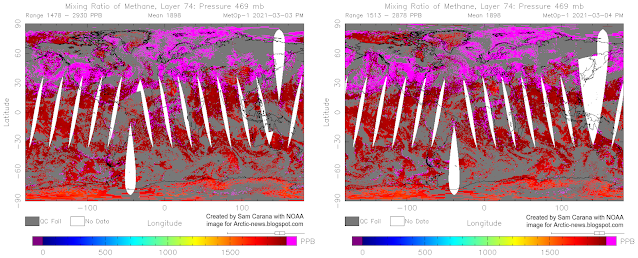The image on the right updates an image from an earlier post, illustrating the difference between using a Gobal Warming Potential (GWP) for methane of 150 over a few years versus 28 over 100 years. The IPCC in its special report Climate Change and Land assessed the impact of AFOLU (agriculture, forestry, and other land use) versus the impact of fossil fuel, etc., by using a GWP for methane of 28 over 100 years, referring to AR5, an earlier IPCC report.
Since AR5 was published, a study found methane's 100-year GWP to be 14% higher than the IPCC value. The image on the right therefore uses a short-term GWP for methane of 171 in the panel on the right-hand side, 14% higher than the 150 used earlier.
When using this 171 GWP for methane and when including pre- and post-production activities in the food system, AFOLU (agriculture, forestry, and other land use) causes about half of people's 2007-2016 emissions.
The black bar for methane at a GWP of 171 in the panel on the right-hand side further shows a far greater impact caused by fossil fuel, etc., in particular by the use of natural gas for heating buildings, generating electricity, etc.
Methane's one-year GWP is 200
The image below shows a trendline that is based on IPCC AR5 data that were similarly updated by 14% and that indicates that methane's one-year GWP is 200.
Methane Levels Rising Rapidly
Of course, it should be painfully clear by now that the unfolding climate collapse is an existential threat, making it obviously and vitally important to act on methane. We simply cannot afford to delay action, we cannot afford to do so financially nor in any other way. So, what can and should be done?
 |
| Above suggestion to take strong action was posted Nov. 9, 2020 at facebook |
 |
| Image from the 2014 post Biochar Builds Real Assets |
That way, real assets are built.
Such a methane burst of about 5 Gt alone could suffice to raise the CO₂e level to 1200 ppm and trigger a further 8°C global temperature rise due to the clouds feedback.
As discussed in an earlier post, next to seafloor methane, there are further warming elements that could contribute to a rapid acceleration of the temperature rise.
The situation is dire and calls for immediate, comprehensive and effective action as described in the Climate Plan.
Links
• Climate Plan
https://arctic-news.blogspot.com/p/climateplan.html
• IPCC special report Climate Change and Land
https://www.ipcc.ch/report/srccl
• IPCC Report Climate Change and Land
https://arctic-news.blogspot.com/2019/08/ipcc-report-climate-change-and-land.html
• Radiative forcing of carbon dioxide, methane, and nitrous oxide: A significant revision of the methane radiative forcing - by Maryam Etminan et al. (2018)
https://agupubs.onlinelibrary.wiley.com/doi/full/10.1002/2016GL071930
• IPCC keeps feeding the addiction
https://arctic-news.blogspot.com/2018/10/ipcc-keeps-feeding-the-addiction.html
• How much warming have humans caused?
https://arctic-news.blogspot.com/2016/05/how-much-warming-have-humans-caused.html
• Most Important Message Ever
https://arctic-news.blogspot.com/2019/07/most-important-message-ever.html
• January 2021 executive order by President Biden on Protecting Public Health and the Environment and Restoring Science to Tackle the Climate Crisis
• NOAA mean global carbon methane
• NOAA mean global carbon dioxide
• Why stronger winds over the North Atlantic are so dangerous
https://arctic-news.blogspot.com/2020/02/why-stronger-winds-over-north-atlantic-are-so-dangerous.html
• Feedbacks in the Arctic
https://arctic-news.blogspot.com/p/feedbacks.html
• When will we die?
https://arctic-news.blogspot.com/2019/06/when-will-we-die.html
• A rise of 18°C or 32.4°F by 2026?
https://arctic-news.blogspot.com/2019/02/a-rise-of-18c-or-324f-by-2026.html
• Methane Hydrates Tipping Point threatens to get crossed
https://arctic-news.blogspot.com/2020/08/methane-hydrates-tipping-point-threatens-to-get-crossed.html
• Arctic Hit By Ten Tipping Points
https://arctic-news.blogspot.com/2020/04/arctic-hit-by-ten-tipping-points.html
• Crossing the Paris Agreement thresholds
https://arctic-news.blogspot.com/p/crossing.html
• 2°C crossed
https://arctic-news.blogspot.com/2020/03/2c-crossed.html
• Most Important Message Ever
https://arctic-news.blogspot.com/2019/07/most-important-message-ever.html
• Blue Ocean Event
https://arctic-news.blogspot.com/2018/09/blue-ocean-event.html
• Record Arctic Warming
https://arctic-news.blogspot.com/2016/04/record-arctic-warming.html
• There is no time to lose
https://arctic-news.blogspot.com/2020/11/there-is-no-time-to-lose.html
• Warning of mass extinction of species, including humans, within one decade
https://arctic-news.blogspot.com/2017/02/warning-of-mass-extinction-of-species-including-humans-within-one-decade.html
• Extinction
https://arctic-news.blogspot.com/p/extinction.html
• 2020: Hottest Year On Record



























